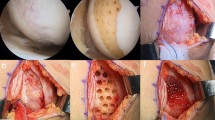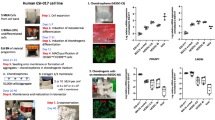Abstract
Bone marrow presents an attractive option for the treatment of articular cartilage defects as it is readily accessible, it contains mesenchymal progenitor cells that can undergo chondrogenic differentiation and, once coagulated, it provides a natural scaffold that contains the cells within the defect. This study was performed to test whether an abbreviated ex vivo protocol using vector-laden, coagulated bone marrow aspirates for gene delivery to cartilage defects may be feasible for clinical application. Ovine autologous bone marrow was transduced with adenoviral vectors containing cDNA for green fluorescent protein or transforming growth factor (TGF)-β1. The marrow was allowed to clot forming a gene plug and implanted into partial-thickness defects created on the medial condyle. At 6 months, the quality of articular cartilage repair was evaluated using histological, biochemical and biomechanical parameters. Assessment of repair showed that the groups treated with constructs transplantation contained more cartilage-like tissue than untreated controls. Improved cartilage repair was observed in groups treated with unmodified bone marrow plugs and Ad.TGF-β1-transduced plugs, but the repaired tissue from TGF-treated defects showed significantly higher amounts of collagen II (P<0.001). The results confirmed that the proposed method is fairly straightforward technique for application in clinical settings. Genetically modified bone marrow clots are sufficient to facilitate articular cartilage repair of partial-thickness defects in vivo. Further studies should focus on selection of transgene combinations that promote more natural healing.
This is a preview of subscription content, access via your institution
Access options
Subscribe to this journal
Receive 12 print issues and online access
$259.00 per year
only $21.58 per issue
Buy this article
- Purchase on Springer Link
- Instant access to full article PDF
Prices may be subject to local taxes which are calculated during checkout




Similar content being viewed by others
References
Saris DB, Vanlauwe J, Victor J, Haspl M, Bohnsack M, Fortems Y et al. Characterized chondrocyte implantation results in better structural repair when treating symptomatic cartilage defects of the knee in a randomized controlled trial versus microfracture. Am J Sports Med 2008; 36: 235–246.
Brittberg M, Lindahl A, Nilsson A, Ohlsson C, Isaksson O, Petrson L . Treatment of deep cartilage defects in the knee with autologous chondrocyte transplantation. N Engl J Med 1994; 331: 889–895.
Buckwalter JA, Brown TD . Joint injury, repair and remodeling: roles in post-traumatic osteoarthritis. Clin Orthop Relat Res 2004; 423: 7–16.
Ghivizzani SC, Oligino TJ, Robbins PD, Evans CH . Cartilage injury and repair. Phys Med Rehab Clin North Am 2000; 11: 289–307.
Pittenger MF, Mackay AM, Beck SC, Jaiswal RK, Douglas R, Mosca JD et al. Multilineage potential of adult human mesenchymal stem cells. Science 1999; 284: 143–147.
Glansbeek HL, van Beuningen HM, Vitters EL, van der Kraan PM, van den Berg WB . Stimulation of articular cartilage repair in established arthritis by local administration of transforming growth factor beta into murine knee joints. Lab Invest 1998; 78: 133–142.
Jelic M, Pecina M, Haspl M, Kos J, Taylor K, Maticic D et al. Regeneration of articular cartilage chondral defects by osteogenic protein-1 (bone morphogenetic protein-7) in sheep. Growth Factors 2001; 19: 101–113.
Fortier LA, Mohammed HO, Lust G, Nixon AJ . Insulin-like growth factor I enhances cell-based repair of articular cartilage. J Bone Joint Surg Br 2002; 84-B: 95–108.
Kaps C, Bramlage C, Smolian H, Haisch A, Ungethüm U, Burmester GR et al. Bone morphogenetic proteins promote cartilage differentiation and protect engineered artificial cartilage from fibroblast invasion and destruction. Arthritis Rheum 2002; 46: 149–162.
Evans CH, Ghivizzani SC, Smith P, Shuler FD, Mi Z, Robbins PD . Using gene therapy to protect and restore cartilage. Clin Orthop Relat Res 2000; 379: 214–219.
Evans CH, Ghivizzani SC, Robbins PD . Orthopaedic gene therapy. Clin Orthop Relat Res 2004; 429: 316–329.
Kang R, Marui T, Ghivizzani SC, Nita IM, Georgescu HI, Suh JK et al. Ex vivo gene transfer to chondrocytes in full-thickness articular cartilage defects: a feasibility study. Osteoarthr Cartil 1997; 5: 139–143.
Mason JM, Grande DA, Barcia M, Grant R, Pergolizzi RG, Breitbart AS . Expression of human bone morphogenetic protein 7 in primary rabbit periosteal cells: potential utility in gene therapy for osteochondral repair. Gene Ther 1998; 5: 1098–1104.
Safran MR, Kim H, Zaffagnini S . The use of scaffolds in the management of articular cartilage injury. J Am Acad Orthop Surg 2008; 16: 306–311.
Pascher A, Palmer GD, Steinert A, Oligino T, Gouze E, Gouze J-N et al. Gene delivery to cartilage defects using coagulated bone marrow aspirate. Gene Ther 2004; 11: 133–141.
Yeh P, Perricaudet M . Advances in adenoviral vectors: from genetic engineering to their biology. FASEB 1997; 11: 615–623.
Hardy S, Kitamura M, Harris-Stansil T, Dai Y, Phipps ML . Construction of adenovirus vectors through Cre-lox recombination. J Virol 1997; 71: 1842–1849.
Mainil-Varlet P, Aigner T, Brittberg M, Bullough P, Hollander A, Hunziker E et al. Histological assessment of cartilage repair. J Bone J Surg Am 2003; 85-A: 45–57.
Dickinson SC, Sims TJ, Pittarello L, Soranzo C, Pavesio A, Hollander AP . Quantitative outcome measures of cartilage repair in patients treated by tissue engineering. Tissue Eng 2005; 11: 277–287.
Cucchiarini M, Madry H, Ma C, Thurn T, Zurakowski D, Menger MD et al. Improved tissue repair in articular cartilage defects in vivo by rAAV-mediated overexpression of human fibroblast growth factor 2. Mol Ther 2005; 12: 229–238.
Handley CJ, Buttle DJ . Assay of proteoglycan degradation. Methods Enzymol 1995; 248: 47–58.
Stolz M, Raiteri R, Daniels AU, Van Landingham MR, Baschong W, Aebi U . Dynamic elastic modulus of porcine articular cartilage determined at two different levels of tissue organization by indentation-type atomic force microscopy. Biophys J 2004; 86: 3269–3283.
Aroen LS, Heir S, Alvik E, Ekeland A, Granlund OG, Engebretsen L . Articular cartilage lesions in 993 consecutive knee arthroscopies. Am J Sports Med 2004; 32: 211–215.
Freed LE, Guilak F, Guo EX, Gray ML, Tranquillo R, Holmes JW et al. Advanced tools for tissue engineering: scaffolds, bioreactors, and signaling. Tissue Eng 2006; 12: 3285–3305.
Ahern BJ, Parvizi J, Boston R, Schaer TP . Preclinical animal models in single site cartilage defect testing: a systematic review. Osteoarthr Cartil 2009; 17: 705–713.
Caplan AI . Mesenchymal stem cells and gene therapy. Clin Orthop Relat Res 2000; 379: S67–S70.
Goldring MB, Tsuchimochi K, Ijiri K . The control of chondrogenesis. J Cell Biochem 2006; 97: 33–44.
Chen FH, Rousche KT, Tuan RS . Technology insight: adult stem cells in cartilage regeneration and tissue engineering. Nat Clin Pract Rheumatol 2006; 2: 373–382.
Tuli R, Tuli S, Nandi S, Huang X, Manner PA, Hozack WJ et al. Transforming growth factor-beta-mediated chondrogenesis of human mesenchymal progenitor cells involves N-cadherin and mitogen-activated protein kinase and Wnt signaling cross-talk. J Biol Chem 2003; 278: 412–427.
Palmer GD, Steinert A, Pascher A, Gouze E, Gouze J, Betz O et al. Gene-induced chondrogenesis of primary mesenchymal stem cells in vitro. Mol Ther 2005; 2: 219–228.
Lee KH, Song SU, Hwang TS, Yi Y, Oh IS, Lee JY et al. Regeneration of hyaline cartilage by cell-mediated gene therapy using transforming growth factor beta 1-producing fibroblasts. Hum Gene Ther 2001; 12: 1805–1813.
Guo CA, Liu XG, Huo JZ, Jiang C, Wen XJ, Chen ZR . Novel gene-modified-tissue engineering of cartilage using stable transforming growth factor-beta1-transfected mesenchymal stem cells grown on chitosan scaffolds. J Biosci Bioeng 2007; 103: 547–556.
Pagnotto MR, Wang Z, Karpie JC, Feretti M, Xiao X, Chu CR . Adeno-associated viral gene transfer of transforming growth factor-ß1 to human mesenchymal stem cells improves cartilage repair. Gene Ther 2007; 14: 804–813.
McPhee SW, Janson CG, Li C, Samulski RJ, Camp AS, Francis J et al. Immune response to AAV in phase I study for Canavan disease. J Gene Med 2006; 8: 577–588.
Yaeger PC, Masi TL, de Ortiz JL, Binette F, Tubo R, McPherson JM . Synergistic action of transforming-growth factor-beta and insulin-like growth factor-I induces expression of type II collagen and aggrecan genes in adult articular chondrocytes. Exp Cell Res 1997; 237: 318–325.
Steinert AF, Palmer GD, Pilapil C, Ulrich N, Evans CH, Ghivizzani SC . Enhanced in vitro chondrogenesis of primary mesenchymal stem cells by combined gene transfer. Tissue Eng 2008; 14: 1–13.
Kafienah W, Mistry S, Dickinson SC, Sims TJ, Learmonth I, Hollander AP . Three-dimensional cartilage tissue engineering using adult stem cells from osteoarthritis patients. Arthritis Rheumat 2007; 56: 177–187.
Steadman JR, Briggs KK, Rodrigo JJ, Kocher MS, Gill TJ, Rodkey WG . Outcomes of microfracture for traumatic chondral defects of the knee: average 11-year follow-up. Arthroscopy 2003; 19: 477–484.
Steadman JR, Rodkey WG, Rodrigo JJ . Microfracture: surgical technique and rehabilitation to treat chondral defects. Clin Orthop Relat Res 2001; 391 (Suppl): S362–S369.
Poole AR, Kojima T, Yasuda T, Mwale F, Kobayashi M, Laverty S . Composition and structure of articular cartilage: a template for tissue repair. Clin Orthop Relat Res 2001; 391 (Suppl): S26–S33.
Appleyard RC, Swain MV, Khanna GA, Murrell GA . The accuracy and reliability of novel handheld dynamic indentation probe for analysing articular cartilage. Phys Med Biol 2001; 46: 541–550.
Lyyra T, Jurvelin J, Pitkanen U, Vaatainen U, Kiviranta I . Indentation instrument for the measurement of cartilage stiffness under arthroscopic control. Med Eng Phys 1995; 17: 395–399.
Stolz M, Aebi U, Stoffler D . Developing scanning probe-based nanodevicesμ—stepping out of the laboratory into the clinic. Nanomedicine 2007; 3: 53–62.
Swanepoel MW, Smeathers JE, Adams LM . The stiffness of human apophyseal articular cartilage as an indicator of joint loading. Proc Inst Mech Eng H (J Eng Med) 1994; 208: 33–43.
Van Beuningen HM, van der Kraan PM, Arntz OJ, van den Berg WB . Transforming growth factor-β1 stimulates articular chondrocyte proteoglycan synthesis and induces osteophyte formation in the murine knee joint. Lab Invest 1994; 71: 279–290.
Evans CH, Palmer GD, Pascher A, Porter RM, Kwong FN, Gouze E et al. Facilitated endogenous repair: making tissue engineering simple, practical and economical. Tissue Eng 2007; 8: 1987–1993.
Acknowledgements
We thank Pierre Mainil-Varlet, MD, PhD, Davor Jezek, MD, PhD, Andreja Vukasovic and Ivan Cerovecki for assistance in histological analysis; Snjezana Martinovic, MD, PhD for valuable insight in designing this study; Mario Kreszinger, DVM, PhD, Drazen Vnuk, DVM, PhD, and Norbert Kastner, MD, for assistance during animal surgeries; and Fran Borovecki, MD, PhD, for his work with PCR analysis. This study was supported by the Croatian Ministry of Science (projects No. 108-0000000-3652 and 108-1080327-0161). Marko Loparic acknowledges an NCCR ‘Nanoscale Science’ grant, awarded by the Swiss National Science Foundation to Ueli Aebi and Ivan Martin.
Author information
Authors and Affiliations
Corresponding author
Ethics declarations
Competing interests
The authors declare no conflict of interest.
Rights and permissions
About this article
Cite this article
Ivkovic, A., Pascher, A., Hudetz, D. et al. Articular cartilage repair by genetically modified bone marrow aspirate in sheep. Gene Ther 17, 779–789 (2010). https://doi.org/10.1038/gt.2010.16
Received:
Revised:
Accepted:
Published:
Issue Date:
DOI: https://doi.org/10.1038/gt.2010.16
Keywords
This article is cited by
-
Biomaterial-guided delivery of gene vectors for targeted articular cartilage repair
Nature Reviews Rheumatology (2019)
-
Current Trends in Viral Gene Therapy for Human Orthopaedic Regenerative Medicine
Tissue Engineering and Regenerative Medicine (2019)
-
Sheep embryonic stem-like cells engrafted into sheep femoral condyle osteochondral defects: 4-year follow-up
BMC Veterinary Research (2018)
-
Gene therapy for chondral and osteochondral regeneration: is the future now?
Cellular and Molecular Life Sciences (2018)
-
Impact of mechanical stimulation on the chondrogenic processes in human bone marrow aspirates modified to overexpress sox9 via rAAV vectors
Journal of Experimental Orthopaedics (2017)



